 |
 |
 |
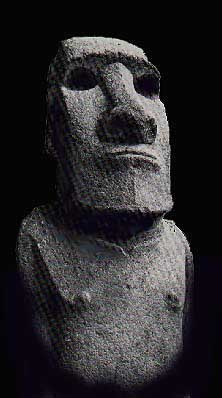 |
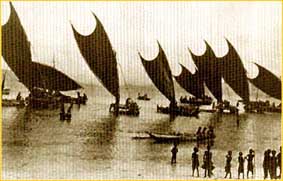 |
| HF Radio Communications In The Pacific |
| The vast area of the Pacific Ocean, the largest in the world and the world's most romantic, exceeds that of all dry land, and was one of the last areas on our planet to be explored. From the jungles of Papua New Guinea, the scattered coral and volcanic islands of the South Seas, to the cosmopolitan cities of Australia and New Zealand, we find a very unique and fascinating mixture of cultures. |
| Oceania, covers all of the southern region known as the South Pacific. Australia, New Zealand and Papua New Guinea along with the main island groups of Micronesia, Melanesia and Polynesia. Together, they form one of the most diverse and fascinating areas on earth. It is also one of the remotest areas, with its countless islands spread over 38,850 ,000 sq. km. Throughout the Pacific, HF radio still plays an important part in communications. Even in these days of satellite phone service, computers and the internet. Most of the communications carried on in this vast and remote area is on the high frequency bands. On many larger islands radio is used for general purposes, as not all will have a reliable phone service. Amateur radio is very widely used. In Guam and the other U.S. territories and possessions in the Pacific, there are over 1000 licensed amateurs, and countless more who operate on other HF frequencies. Ham operators play an important role in providing emergency communications during times of disaster or medical emergencies. There are several voluntary organizations, such as HSVOAD (Hawaii State Voluntary Organization Active in Disaster) who run emergency tests using volunteer amateur radio operators and CB stations. Natural disasters, including tropical cyclones, hurricanes or typhoons, tsunamis, earthquakes, etc. are common. For a rapid response to these situations, communications is critical. 11 Meter Band In the Kiribatti Island group alone, there are thousands of CB radio operators, and many of these operate within the official 27 MHz Citizen Band, usually between Channel 30 and 38 usb. Many also operate on the 11 Meter "Freeband", keeping in contact with friends and relations in New Zealand and Australia. Also, there are many "local" DX calling frequencies, such as, 27.515 lsb used by the PIG (Peace International Group) whose members cover much of the Pacific area. |
| The allocated frequencies for the official 11 Meter CB in New Zealand is 26.330-26.770 MHz 40 Channels AM/USB/LSB 4 watts AM / 12 watts SSB. In Australia, the official 11 Meter CB is 26.965-27.405 MHz 40 Channels AM/USB/LSB 4watts AM/ 12watts SSB. Much of the Island CB communications is on the USB in the higher end of the band between 27.305 MHz and 27.385 MHz. |
| PLEASE BE AWARE OF THE AUSTRALIAN 27 MHz MARINE FREQUENCIES 27.680 MHz to 27.980 MHz |
 |
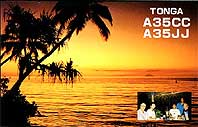 |
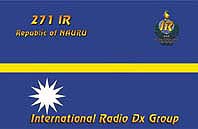 |
 |
 |
 |
 |
 |
| A rare QSL Card from Radio Free Bougainville The station was set up in 1992 by Sam Voron VK2BVS, who also organized a relief operation for desperately needed medical supplies. Radio Free Bougainville broadcast daily pleas for medicine as hundreds of islanders were dying of diseases. Since then, Sam has been involved in organizing humanitarian aid to other areas throughout the world. For more information on the history of Radio Bougainville visit http://radiodx.com/spdxr/RFB.htm A background history to the Bougainville conflict with P.N.G. |
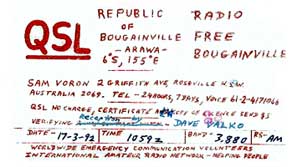 |
| "HOURS AHEAD WHEN MINUTES COUNT" |
| International Amateur Radio Network |
| IARN is an association involved in the emergency deployment of HAMS and other volunteers into emergency situations. The International Amateur Radio Network was born on September 19, 1985 after the devastating earthquake in Mexico City. The Sydney I.A.R.N broadcasts daily: 145.5MHz FM - in the 2 Metre Band, and 27.295MHz LSB - Australian CB Channel 29 LSB. Broadcasting daily from 7am till 11pm with a break for call-ins every 45 minutes. Items are always required by the IARN for Humanitarian Aid. |
| AUSTRALIAN IARN CONTACT INFORMATION |
| ITU Region 3 Coordinator and Australian Dir. is Sam Voron VK2BVS. You can contact Sam Voron (VK2BVS) : by phone (612) 9417 1066 Or you can call or write to Sam at the International Amateur Radio Network Australian HQ at: 2 Griffith AVE Roseville NSW Australia 2069 (Please call for an appointment or to arrange a suitable time before you visit the station.) Now that the two year civil war has ended in the Solomon Islands, Sam is appealing for assistance in the donation of goods to rebuild the lives and spirits of these people and their country. The Amateur Radio Club of Sydney is co-ordinating the collection and distribution of items . Your help does make a difference... |
| For Clandestine radio activities in the Pacific Region visit : Clandestine Radio Watch. |
 |
